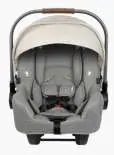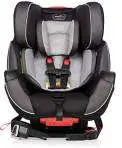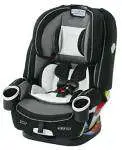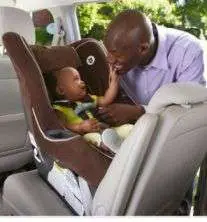You’ve been in the family way for months. And you’re soon going to hold a cute little baby in your arms. But how will you carry your bundle of joy from the hospital? You need the best and safest baby car seat for the job. But there are different types of baby car seats to choose from. And the bazillions of seemingly good options can be dizzying.
Related: 5 Most Compact Car Seats for Tiny Cars
In this post, you’ll learn 7 different kinds of baby safety seats and the pros and cons of each kind. Some work only for newborns and smaller babies. Others work well for all age ranges while others are ideal for larger babies.
But first things first…
A Baby Car Seat Can Save Your Child’s Life — Use It.
The main reason many parents use baby car seats is that all 50 states have car seat laws that require strict adherence. But there’s a reason all US states require baby car seats on the road: child safety.
Well, there’s no such thing as a perfectly flawless product. And car seats for infants and toddlers are no exception.
That said, the benefits of using a car seat far outweigh any disadvantages. Studies find that using a baby car seat correctly can cut injury risk, hospitalization, or death by over 70 percent compared with seat belts or no car seat. As a caring mom or dad, this should be the biggest reason to use this child-restraining device.
Always Use the Right Car Seat the Right Way, Says NHTSA
According to the National Highway Traffic Safety Administration, boosters and car seats protect infants and children during crashes. In 2017 alone, NHTSA crash statistics reveal that car seats saved 325 children under 5 years.
But while this essential piece of baby gear offers great safety benefits, many children (aged 1-13) continue to lose their lives through crashes. Yes, even when they’re using federally approved seats. That’s why the NHTSA recommends using a suitable car seat correctly every time they travel in a car.
Car Seat Laws Keep Changing. Stay Informed.
By the way, car seat laws vary from state to state. Your state’s safety requirements today may be different than what they were when you had your first baby.
You want to stay abreast with these changes to avoid problems with law enforcement. Also, you need to be familiar with the safety regulations of any state you might move to down the road. Here’s a comprehensive resource that contains baby car seat and booster seat regulations in every state.
US Market-focused Baby Car Seats Should Be Safe
Most states require a federally approved car seat or a rear-facing one. You may safely assume that baby car seat manufacturers for the US market make 100% compliant seats.
Well, it’s not like the federal government inspects every seat before releasing it to end-users. Manufacturers pretty much self-regulate, but spot checks happen continually and no company wants to be on the wrong side of car seat safety compliance.
7 Types of Baby Car Seats You Should Know (Type #7 is Cool!)
There are 7 kinds of car seats namely:
- Rear-facing car seats/ Infant car seats
- Forward-facing seats/Combination seats
- Convertible car seats
- All-in-one seats
- Booster seats
- Safety belts
- Rotating car seats (a sub-type of convertible car seats)
Now, we’ll dive right in and learn what each seat type looks like to help you make your shopping journey easier.
1. Infant Car Seats (Rear-facing-only, for Newborns & Infants)

As the name suggests, infant car seats are designed for infants — newborns and small babies up to 2 years old. This is the kind you want for when you’re driving your kiddo from the hospital. Infant car seats are portable (they have a carry handle), rear-facing-only seats that recline (up to 45 degrees) for comfort and safety.
Some babies grow fast and reach the manufacturer-stated maximum weight and height limit at 12 months. Others don’t grow so fast and it can be up to 2 years before they’re big and tall enough to need a new seat.
Most infant car seats have a minimum weight limit of 4-5 pounds, a maxim weight limit of 30-35 pounds, and a height range of 17″-32″.
Portable and Easily Transferable
The vast majority of infant car seats fit into a base that you strap into your vehicle’s seat. Others allow you to strap them directly into your car’s seat. Having a base makes these seats super easy to transfer between cars. As long as you have extra compatible bases, you can easily use the car seat in different vehicles.
Is your family always on the move? Do you own a bunch of cars? Maybe you Uber some of the time or live in a walking city? If that’s you, a portable rear-facing car seat is the best bet for you.
One great reason to choose an infant car seat is that it fits newborns and infants better than other kinds of car seats.
Pros
- They give newborns and infants the best fit
- Allow for rear-facing seating which is considered the safest position by the American Academy of Pediatricians. The AAP recommends extended rear-facing, from birth up to 2 years.
- Base is detachable, which makes installing them in multiple cars possible
- Usually light and highly portable
- Most are stroller-friendly and can be used to create a travel system
- Pretty easy to install, especially if they have an adjustable base
Cons
- Are never a forever car seat
- Some can be expensive
Can a Preemie Use a Car Seat?
So, can you carry a preemie in an infant seat? Yes, a premature baby can use an infant seat. Some car seats designed for small babies can accommodate really tiny babies, as small as 4 pounds. If your baby is smaller than 4 pounds, it’ll be extremely hard to find something that’ll work for them. If that’s the situation you’re looking at, consider getting a car bed for them before introducing them to an infant seat.
Is It OK to Use a Hand-me-down Infant Seat?
A small baby can use a hand-me-down seat as long as it’s in good condition, hasn’t expired yet, and has never been involved in an accident. Baby car seat makers normally indicate each product’s expiration date.
It’s critical to check what the stated expiration date is so that you don’t end up using something that’ll put your infant’s life at risk. Here’s what car seat expiration date is and why it matters.
How Long Should a Baby Use a Rear-facing Seat?
As long as possible according to the NHTSA and the American Academy of Pediatrics. The NHTSA advises parents to ride with their children in the rear-facing position for at least 3 years.
Another way to know it’s time to change to something different is when the baby reaches the car seat manufacturer-indicated weight/height limits. At that point, you can gift your child an all-in-one seat or a convertible option.
Why do safety experts keep insisting on the rear-facing position for newborns to 2-year-olds? Scientists say that the rear-facing position is the safest option. The rear-facing seating position distributes crash energy over a large area of the baby’s body.
2. Convertible Car Seats (Rear-facing & Forward-facing Seating)

A convertible car seat offers both rear-facing and forward-facing seating positions. It starts out as a rear-facing car seat (usually 4-40 pounds) and then converts into a forward-facing option. In the forward-facing mode, a top tether must be used as well as a harness, normally a 5-point harness.
Since a convertible car seat offers forward-facing and rear-facing seating positions, you can use it from birth through toddlerhood. Once your baby reaches their second birthday, you may start buckling them in forward-facing.
Unlike infant seats, convertible car seats lack a detachable base. That’s why they’re harder to uproot and install in another vehicle. Also, most of these seats are large and pretty bulky. But being bulky makes the feel quite solid and that makes it feel like they’re safer.
Pros of Convertible Car Seats
- They grow with your child, saving you money.
- They’re bulky and that can give you a sense of increased safety.
- They can be a forever car seat for some
Cons of Convertible Seats
- Not usable as an infant carrier
- Difficult to move between cars
- Not always easy to use for small babies
Generally, convertible car seats are for newborns, infants, and preschoolers.
3. All-in-one Baby Car Seats (Most Versatile)
An all-in-one baby car seat is the most versatile option you can find. This car seat type is a rear-facing infant seat, a forward-facing seat, and a high-back booster seat (3-in-1 options). Some all-in-one options may even convert to a backless booster, which makes them a 4-in-1 option.

3-in-1 vs 4-in-1 Car Seats
A 3-in-1 car seat offers 3 seating modes while a 4-in-1 car seat provides 4 seating modes. Many parents are familiar with 3-in-1 car seats because these seats have existed for years. As long as your baby is big enough/not too small, you can use this seat type from infancy. You won’t have to buy a new seat when your little one grows bigger and weighs more.
A 4-in-1 car seats allows for rear-facing and forward-facing seating while also being a high-backed booster and eventually a no-back booster seat.
Don’t Be Deceived When Choosing an All-in-one Car Seat
Some brands overwhelm moms and dads with confusion when they’re out there shopping for a baby car seat. A friend bought the Evenflo Symphony All-in-One Convertible Car Seat, which is a 3-in-1 option. The label stated the weight limit as 5-110lbs.
The average parent will likely think that this product offers a harness weight limit of 110lbs. But that’s 100% misleading.
The truth is that the Evenflo Symphony rear-faces 5-40lbs and forward-faces in the 22lbs-65lbs range. But when it comes to the actual harness weight limit, it is 5-65lbs and NOT 5-110lbs.
Best 3-in-1 Car Seat?
Consider the Graco Extend2Fit Convertible. Parents love it, and a detailed evaluation by the experts at Wirecutter elected it as the best convertible car seat ever. You could even get an all-in-one car seat that actually rotates! And the Evenflo 360 Gold is the best rotating car seat I know of.
Is That GRACO Argos 65 Really a 3-in-1 Car Seat?

Another misleading example I know of is the GRACO Argos 65. This item is described as being a 3-in-1 harness booster. But is it really what they say it is? No, they lied! Someone I know purchased the GRACO Argos 65.
Nobody ever told them the Argos 65 is actually a combination baby car seat that DOES NOT rear-face at all! I rarely use exclamation marks, but I let myself give in to the temptation because…this is deceptive marketing.
The same goes for the popular Nautilus 65. So, be sure to read honest car seat reviews before whipping out that card. I keep seeing my readers returning this seat once they buy it from Amazon. Because they soon learn it’s not exactly what they wanted.
If you want an option that rear-faces and are shopping off-line, ask the salesperson if the seat actually features a rear-facing belt path.
Best 4-in-1 Baby Car Seats?
As already mentioned, a 4-in-1 car seat is four things at once: a rear-facing, forward-facing, a high-back booster, and a backless booster. And the GRACO 4Ever DLX is one of the best 4-in-1 car seats out there.

The GRACO 4Ever rear-faces at between 4 and 40lbs and forward-faces in the 20-65lbs weight range. What’s more, this product is a high-backed option at 30-100lbs and a backless booster seat in the 40-120lbs weight limit.
Pros
- They’re do-all car seats that rear-face, forward-face as well as offer high-backed and backless booster seat mode
- Most last years, and you may not need another car seat
Cons
- Heavy and bulky
- Tend to be pricey
4. Booster Seats (Belt-positioners)
According to the CDC, children aged 12 or younger should be in a booster seat. But what’s a booster seat? A booster car seat makes the seat belt fit perfectly over your child’s stronger body parts. There are backless booster seats and high-backed boosters.
Now, a backless booster seat is one that boosts or artificially increases the height of your child so that the seat belt can fit them properly. If your car features headrests — which means your child gets adequate head and neck support — you can safely use this option. But backless boosters work best for older kids since they don’t keep moving and shifting during rides.
Related: What’s a Booster Car Seat?
As for a high-backed baby car seat, it does the same job as a backless booster. But unlike the backless option, the high-backed seat supports your child’s neck and head. If your car lacks headrests, definitely use a high-backed booster.
You can choose a dedicated booster seat, or you can get a do-it-all option that works from birth all the way through preschool and beyond. An all-in-one car seat with a 5-point harness and top tether converts into a booster seat as your child develops and gets heavier. And some all-in-one models are usable as a backless booster.
A booster seat typically has a minimum weight of 40lbs. In most cases, this seat type serves your child until they grow to the point where they no longer need a car seat.
Kids in many states stop using the booster seat at 57″. *Moving a child from the booster seat to the seatbelt before they’re mature enough for it isn’t smart.
5. Combination Car Seats (Forward-facing-only)
What’s a combination car seat? A combination car seat is the opposite of a rear-facing only seat because it’s a forward-facing-only car seat. A combination car seat features a removable 5-point harness plus a top tether for restraining 2-year-olds and older children.

Once the child outgrows the detachable harness, you can remove it, effectively converting the seat into a seat-belt-positioning booster.
I bet you’ve heard folks talking about harnessed boosters. They’re actually discussing these forward-facing only options. Technically, they are not harnessed boosters. They’re what they are — combination car seats.
6. Seat Belts (They’re for Adults)
In most states, children are required to use a booster seat all the way through age 8. At that point, you need to introduce your kiddo to the seat belt. But you should only move them if they’ll fit in the adult seatbelt. Learn how the 5-point Seatbelt Fit Test works and use to decide whether your kid is ready for the seatbelt.
According to the founder of Kidsandcar.org, moving a child from f a booster seat to a seat belt isn’t a very good idea. At least, it’s not a bad idea some of the time. In fact, this safety expert believes that the booster seat to seat belt transition is pretty much a “safety demotion.”
Seat Belts Save Lives According to the NHTSA
But there’s no denying that seat belts save lives. If you look at these traffic safety stats published by the NHTSA recently, you’ll see that seat belts help a considerable amount. In fact, seat belts saved close to 15,000 lives of passenger vehicle occupants aged 5 and older in 2017.
Also read: the 5-Step Seatbelt Test
The Washington Post advises parents on how to know that a child is ready for the seat belt. Here’s when your baby should use a seat belt:
- When their feet are flat on the car’s floor, their knees bend over the seat’s edge
- When your child can use a seat belt for the entirety of a ride without issues
- If the shoulder belt no longer sits on their neck, face, and tummy but now sits on their chest and shoulder
- If the child’s back stays flat against the seat’s back
- When the lap belt no longer touches the tyke’s upper thighs and instead sits low on the hips
If your child’s car riding situation checks all 5 boxes, they’re definitely ready for the seat belt.
7. Rotating Convertible Car Seats
Convertible car seats are becoming quite the trend, and you may want to check out a few. Sure, they’re convertible car seats, but they’re more than that because they revolve 90˚-360˚.
The earliest option I’m aware of is Maxi Cosi’s Axiss, an option that rotates 90 degrees. The swivel feature lets you turn the car seat towards the door so you can get baby in and out effortlessly.
Related: Best Rotating Car Seats
Some options rotate 180˚, but the majority rotate 360 degrees. Like all convertible car seats, these ones come with a non-detachable base. As a result, moving them between vehicles can be extremely difficult.
Here’s another thing to know about rotating car seats: they tend not to be FAA-approved. Take the Cybex Sirona S, for example. It’s not aircraft-approved in the USA even though it’s approved in Canada. The Nuna Revv, the newest arrival on the scene, also isn’t aircraft-ready. Even the best swivel car seat on the planet, the Evenflo 360 Gold, isn’t FAA-approved.
Pros
- They rotate, making buckling in babies and removing them extremely easy
- They’re a tad easier to clean because they revolve
- Usable from birth through toddlerhood
Cons
- Big and heavy
- Not stroller friendly
- Base not detachable
- Tend to be pricey
Different Kinds of Baby Car Seats: Final Thoughts
All moms, dads, and other caregivers need to know what car seat types the auto market offers and understand what each works. Because choosing the right car seat for a baby can be extremely confusing when one doesn’t know the difference between the various kinds of seats available.
Rear-facing only seats are for infants and newborns. Bigger babies can use convertible seats, boosters, and eventually seat belts.
Hopefully, you found this car seat type guide helpful. And if you think we left something important out, please let us know in the comments section below. Happy parenting!
As a medical professional practicing in the United States, Joe Waweru medically reviews every piece of relevant content at kiddofreddom.com, but nothing he says here should be construed as medical advice of any kind.

